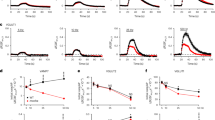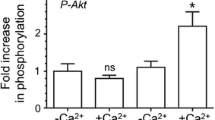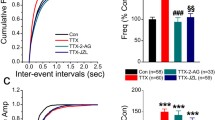Abstract
An enhancement of glutamate release from hippocampal neurons has been implicated in long-term potentiation, which is thought to be a cellular correlate of learning and memory. This phenomenom appears to be involved the activation of protein kinase C and lipid second messengers have been implicated in this process. The purpose of this study was to examine how lipid-derived second messengers, which are known to potentiate glutamate release, influence the accumulation of intraterminal free Ca2+, since exocytosis requires Ca2+ and a potentiation of Ca2+ accumulation may provide a molecular mechanism for enhancing glutamate release. The activation of protein kinase C with phorbol esters potentiates the depolarization-evoked release of glutamate from mossy fiber and other hippocampal nerve terminals. Here we show that the activation of protein kinase C also enhances evoked presynaptic Ca2+ accumulation and this effect is attenuated by the protein kinase C inhibitor staurosporine. In addition, the protein kinase C-dependent increase in evoked Ca2+ accumulation was reduced by inhibitors of phospholipase A2 and voltage-sensitive Ca2+ channels, as well as by a lipoxygenase product of arachidonic acid metabolism. That some of the effects of protein kinase C activation were mediated through phospholipase A2 was also indicated by the ability of staurosporine to reduce the Ca2+ accumulation induced by arachidonic acid or the phospholipase A2 activator melittin. Similarly, the synergistic facilitation of evoked Ca2+ accumulation induced by a combination of arachidonic acid and diacylglycerol analogs was attenuated by staurosporine. We suggest, therefore, that the protein kinase C-dependent potentiation of evoked glutamate release is reflected by increases in presynaptic Ca2+ and that the lipid second messengers play a central role in this enhancement of chemical transmission processes.
Similar content being viewed by others
REFERENCES
Zaltusky, R. A., and Nicoll, R. A. 1990. Comparison of two forms of long-term potentiation in single hippocampal neurons. Science 248:1619–1624.
Linden, D. J., and Routtenberg, A. 1989. The role of protein kinase C in long-term potentiation: a testable model. Brain Res. Rev. 14:279–296.
Barrie, A. P., Nicholls, D. G., Sanchez-Prieto, J., and Sihra, T. S. 1991. An ion locus for the protein kinase C potentiation of transmitter glutamate release from guinea pig cerebrocortical synaptosomes. J. Neurochem. 57:1398–1404.
Terrian, D. M., Ways, D. K., and Gannon, R. L. 1991. A presynaptic role for protein kinase C in hippocampal mossy fiber synaptic transmission. Hippocampus 1:303–314.
Zhang, L., and Dorman, R. V. 1993. Synergistic potentiation of glutamate release by arachidonic acid and oleoyl-acetyl-glycerol. Brain Res. Bull. 32:437–441.
Bazzi, M. D., and Nelsestuen, G. L. 1988. Constituitive activity of membrane-inserted protein kinase C. Biochem. Biophys. Res. Commun. 152:336–343.
Rana, R. S., and Hokin, L. E. 1990. Role of phosphoinositides in transmembrane signaling. Physiol. Rev. 70:115–145.
Murakami, K., Chan, S. Y., and Routtenberg, A. 1986. Protein kinase C activation by cis-fatty acid in the absence of Ca2+ and phospholipids. J. Biol. Chem. 261:15424–15429.
Freeman, E. J., Terrian, D. M., and Dorman, R. V. 1990. Presynaptic facilitation of glutamate release from isolated hippocampal mossy fiber nerve endings by arachidonic acid. Neurochem. Res. 15:743–750.
Damron, D. S., and Dorman R. V. 1993. Involvement of phospholipase A2 and arachidonic acid in the depolarization-evoked accumulation of Ca2+ in hippocampal mossy fiber nerve endings. Neurochem. Res. 18:1231–1237.
Shearman, M. S., Shinomura, T., Oda, T., and Nishizuka, Y. 1991. Protein kinase C subspecies in adult rat hippocampal synaptosomes. Activation by diacylglycerol and arachidonic acid. FEBS Lett. 279:261–264.
Hirata, K., Sawada, S., and Yamamoto, C. 1991. Enhancement of transmitter release accompanying with long-term potentiation in synapses between mossy fibers and CA3 neurons in hippocampus. Neurosci. Lett. 123:73–76.
Terrian, D. M., Johnston, D., Clairborne, B. J., Ansah-Yiadom, R., Strittmatter, W. J., and Rea, M. A. 1988. Glutamate and dynorphin release from a subcellular fraction enriched in mossy fiber synaptosomes. Brain Res. Bull. 21:343–351.
Dorman, R. V., Hamm, T. F. R., Damron, D. S., Freeman, E. J. 1992. Modulation of glutamate release from hippocampal mossy fiber nerve endings by arachidonic acid and eicosanoids. Pages 121–136, in Bazan, N. G. (ed.), Neurobiology of Essential Fatty Acids. Plenum Press, New York.
Layne, E. 1957. Spectrophotometer and turbid metric methods for measuring protein. Pages 447–454, in Colowick, S. P., and Kaplan, N. O. (eds.), Methods in Enzymology, Vol III. Academic Press, New York.
Yates, S. L., Fluhler, E. N., and Lippiello, P.M. 1992. Advances in the use of the fluorescent probe fura-2 for the estimation of intrasynaptosomal calcium. J. Neurosci. Res. 32:255–260.
Grynkiewcz, G., Poenie, M., and Tsien, R. Y. 1985. A new generation of Ca2+ indicators with greatly improved fluorescence properties. J. Biol. Chem. 260:3440–3450.
Freeman, E. J., Damron, D. S., Terrian, D. M., and Dorman, R. V. 1991. 12-Lipoxygenase products attenuate the glutamate release and Ca2+ accumulation evoked by depolarization of hippocampal mossy fiber nerve endings. J. Neurochem. 56:1079–1082.
Graham, L. T., and Aprison M. H. 1966. Fluorometric determination of aspartate, glutamate and gamma-aminobutyrate in nerve tissue using enzymic methods. Anal. Biochem. 15:487–497.
Agoston, D. V., and Kuhnt, U. 1986. Increased Ca-uptake of presynaptic terminals during long-term potentiation in hippocampal slices. Exp. Brain Res. 62:663–668.
Lester, D. S., Collin, C., Etcheberrigaray, R., and Alkon, D. L. 1991. Arachidonic acid and diacylglycerol act synergistically to activate protein kinase C in vitro and in vivo. Biochem. Biophys. Res. Commun. 179:1522–1528.
Shinomura, T., Asaoka, Y., Oka, M., Yoshida, K., and Nishizuka, Y. 1991. Synergistic action of diacylglycerol and unsaturated fatty acid for protein kinase C activation: its possible implications. Proc. Natl. Acad. Sci. USA 88:5149–5153.
Kato, K., Uruno, K., Saito, K., and Kato, H. 1991. Both arachidonic acid and 1-oleoyl-2-acetylglycerol in low magnesium solution induce long-term potentiation in hippocampal CA1 neurons in vitro. Brain Res. 563:94–100.
Terrian, D. M., Ways, D. K., Gannon, R. L., and Zetts, D. A. 1993. Tranduction of a protein kinase C-generated signal into the long-lasting facilitation of glutamate release. Hippocampus 3:205–220.
Kim, D. K., Rordorf, G., Nemenoff, R. A., Koroshetz, W. J., and Bonventre, J. V. 1995. Glutamate stably enhances the activity of two cytosolic forms of phospholipase A2 in brain cortical cultures. J. Biochem. 310:83–90.
Qui, Z.-H., DeCarvalho, M. S., and Leslie, C. C. 1993. Regulation of phospholipase A2 activation by phosphorylation in mouse peritoneal macrophages. J. Biol. Chem. 268:24506–24513.
Yamada, H., and Bitar, K. N. 1995. Phospholipase A2-activating peptide-induced contraction of smooth muscle is mediated by protein kinase C-MAP kinase cascade. Biochem. Biophys. Res. Comm. 217:203–210.
Zheng, W. H., Fink, D. W., Jr., and Guroff, G. 1996. Role of protein kinase C α in nerve growth factor-induced arachidonic acid release from PC 12 cells. J. Neurochem. 66:1868–1875.
Normandin, M., Gagne', J., Bernard, J., Elie, R., Miceli, D., Baudry, M., and Massicotte, G. 1996. Involvement of the 12-lipoxygenase pathway of arachidonic acid metabolism in homosynaptic long-term depression of the rat hippocampus. Brain Res. 730:40–46.
Zhang, L., Ruehr, M. L., and Dorman, R. V. 1996. Arachidonic acid and oleyolacetylglycerol induce a synergistic facilitation of Ca2+-dependent glutamate release from hippocampal mossy fiber nerve endings. J. Neurochem. 66:177–185.
Akerman, K. E. O. 1989. Depolarization of neuroblastoma cells as a result of muscarinic receptor-induced rise in cytosolic Ca2+. FEBS Letts. 242:337–340.
Burns, D. J., and Bell, R. M. 1991. Protein kinase C contains two phorbol ester binding domains. J. Biol. Chem. 266:18330–18338.
Lester, D. S. 1990. In vitro linoleic acid activation of protein kinase C. Biochim. Biophys. Acta 1054:297–303.
Lester, D. S., and Bramham, C. R. 1993. Persistent, membrane-associated protein kinase C: from model membranes to synaptic long-term potentiation. Cellular Signaling 5:695–708.
Chauhan, V. P. S., Chauhan, A., Deshmukh, D. S., and Brockerhoff, H. 1990. Lipid activators of protein kinase C. Life Sciences 47:981–986.
Bazan, N. G. 1970. Effects of ischemia and electroconvulsive shock on free fatty acid pool in the brain. Biochim. Biophys. Acta 218:1–10.
Dorman, R. V., Dabrowiecki, Z., and Horrocks, L. A. 1983. Effects of CDPcholine and CDPethanolamine on the alterations in rat brain lipid metabolism induced by global ischemia. J. Neurochem. 40:276–279.
Schachter, J. B., Lester, D. S., and Alkon, D. L. 1996. Synergistic activation of protein kinase C by arachidonic acid and diacylglycerols in vitro: Generation of a stable membrane-bound, cofactor-independent state of protein kinase C activity. Biochem. Biophys. Acta 1291:167–176.
Bramham, C. R., Alkon, D. L., and Lester, D. S. 1994. Arachidonic acid and diacylglycerol act synergistically through protein kinase C to persistently enhance synaptic transmission in the hippocampus. Neurosci. 60:737–743.
Storm-Mathisen, J. 1977. Localization of transmitter candidates in the brain: the hippocampal formation as a model. Prog. Neurobiol. 8:119–181.
Hopkins, W. F., and Johnston, D. 1984. Frequency-dependent noradrenergic modulation of long-term potentiation in the hippocampus. Science 226:350–352.
Gray, R., and Johnston, D. 1987. Noredrenaline and β-adrenoceptor agonists increase activity of voltage-dependent calcium channels in hippocampal neurons. Nature 327:620–622.
Diamant, S., Lev-Ari, I., Uzielli, I., and Atlas, D. 1988. Muscarinic agonists evoke neurotransmitter release: possible roles for phosphatidylinositol biphosphate breakdown products in neuromodulation. J. Neurochem. 51:795–802.
Schoepp, D. D., Johnson, B. G., True, R. A., and Monn, J. A. 1991. Comparison of (1S,3R)-1-aminocyclopentane-1,3-dicarboxylic acid (1S,3R-ACPD) and 1R,3S-ACPD-stimulated brain phosphoinositide hydrolysis. Eur. J. Pharm. 207:351–353.
Cole, A. E., and Nicoll, R. A. 1983. Acetylcholine mediates a slow synaptic potential in hippocampal pyramidal cells. Science 221:1299–1301.
Herrero, I., Miras-Portugal, M. T., and Sanchez-Prieto, J. 1992. Positive feedback of glutamate axocytosis by metabotropic presynaptic receptor stimulation. Nature 360:163–166.
Collins, D. R., and Davies, S. N. 1993. Co-administration of (1S,3R)-1-aminocyclopentane-1,3-dicarboxylic acid and arachidonic acid potentiates synaptic potentiation in rat hippocampal slices. Eur. J. Pharm. 240:325–326.
Prekeris, R., Mayhew, M. W., Cooper, J. B., and Terrian, D.M. 1996. Identification and localization of an actin-binding motif that is unique to the epsilon isoform of protein kinase C and participates in the regulation of synaptic function. J. Cell Biol. 132: 77–90.
Author information
Authors and Affiliations
Rights and permissions
About this article
Cite this article
Ruehr, M.L., Zhang, L. & Dorman, R.V. Lipid-Dependent Modulation of Ca2+ Availability in Isolated Mossy Fiber Nerve Endings. Neurochem Res 22, 1215–1222 (1997). https://doi.org/10.1023/A:1021976828513
Issue Date:
DOI: https://doi.org/10.1023/A:1021976828513




